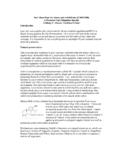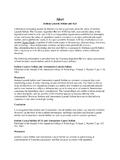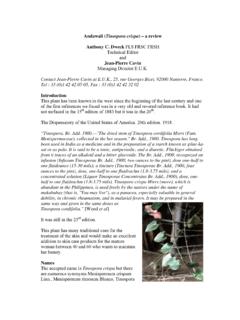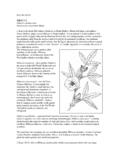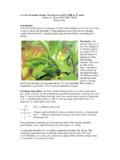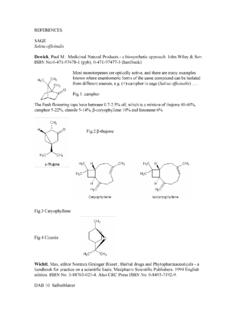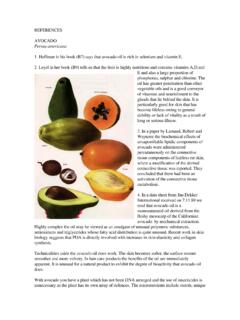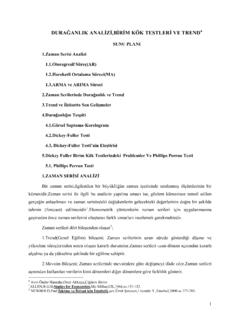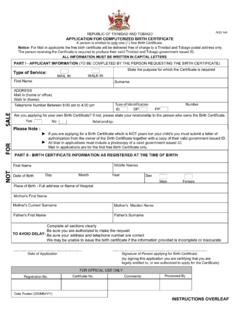Transcription of A review of Guava (Psidium guajava) - Anthony Dweck
1 A review of Guava ( psidium guajava ). Anthony C. Dweck FLS FRSC FRSH. Dweck Data Introduction In the next of our series on Far Eastern plant we look at Guava or psidium guajava In folk medicine, extracts of roots, bark, and leaves are used to treat gastroenteritis, vomiting, diarrhoea, dysentery, wounds, ulcers, toothache, coughs, sore throat, inflamed gums, and a number of other conditions (Morton 1987). This plant seemed worthy of an in depth review . Family: Myrtaceae Common names: Common Guava , yellow Guava , apple Guava . Bayabas, kalimbahin, tayabas, guayabas. Bisayan: Bayabas (Tagalog); Bayabas, guayabas (llokano). [Ticzon]. It also has the common names according to the Philippine dialects shown here: Bayabas, guayabas, tayabas, kalimbahin (Tag.)
2 ; bayabas (Ilk., Bis., Ibn.); bagabas (Ig.);. biabas (Sul.); bayaya (Bik.); gaiyabat, gaiyabit (If.); gayabas (Bon.) [Hernandez]. In addition, more local and dialect Phillipine names are given as: Bagabas (Ig); bayabas (Ibn., Ilk., Tag., C. Bis.), bayaua (Bik.); bayabo (Ibn.);. getabas (Bon.); guyabas (Ilk.) [Quisumbing]. In Malay the local names are: Jambu burung, Jambu padang, Jambu berasu, Jambu bereksa, Jambu buyawas, Jambu melukut, Jambu Portugal, Jambu batu, Jambu pelawas, Jambu biji, Jambu biyawas [Zakaria]. In Africa the names are: gwaabaa (Hausa); woba (Efik);. ugwoba (Igbo); guafa (Yoruba) [Iwu]. In Indian dialects: Sans: Perala; Amratafalam;. Amruta-phalam. Hind: Lal sufrium (red); Amrut. Ben: Lal peyara (red); Goachi-phal.
3 Peyara; Pyara; Piyra. Bom: Perala. Tel: Jama; Jam-pandu; Goya-pandu. Tam: Koyapalam; Koyya; Goyya-pazham (Segapu). Mal: Palamper. Can: Perala-hannu. Jama-phala; Shebe-hannu. Kon: Paera. Sind: Zetton; jamphal. Mah: Peru; Jamba. Guj: Jamrukh. Assam: Madhuria. Nepal: Amuk. Arab & Pers: Amrud. Punj: Amrut. Burm: Malakabeng [Nadkarni and Nadkarni]. Ghana: gua, aduaba; oguawa, eguaba, gouwa, aduaba. India: mansala, amrud, peyara, perala, koyya, goyya, lal-jam, sufed-jam, tambara peru, pandhara peru, shivappu-goyya-pazham, vellai-goyya-pazham, tella- jam-pandu, erra-jam-pandu, beli-shebi-hannu, kempu-dhibe-hannu, dhop-goachi-phal, lal-goachi-phal, lal-safri-am, sufed-safri-am [Ayensu]. Piyara; [Dey]. Description: It is a low evergreen tree or shrub 6 to 25 feet high, with wide-spreading branches and square, downy twigs, is a native of tropical America.
4 It is a common vegetation cover by roads and in waste places in Hawaii. Guava is a tropical and semitropical plant. It is well known in the islands for its edible fruit. It is common in the backyards. The branches are crooked, bringing opposite leaves. The flowers are white, incurved petals, 2 or 3 in the leaf axils, they are fragrant, with four to six petals and yellow anthers. The fruit is small, 3 to 6 cm long, pear-shaped, reddish-yellow when ripe. Chemical composition The fruit The fruits also contain vitamin C [Hernandez] vitamin A, iron, calcium and phosphorus [Iwu, Burkill]. Guavas are up to 5 times richer in vitamin C than oranges [Conway]. Manganese is also present in the plant OH. in combination with phosphoric, oxalic and malic acids [Nadkarni & Nadkarni].
5 The fruit contains HO O. saponin combined with oleanolic acid. Morin-3- OH. O- -L-lyxopyranoside and morin-3-O- -L- O. arabopyranoside and flavonoids, guaijavarin O. ( ) and quercetin ( ) [Arima and Danno]. OH O HO. OH OH. Guaijavarin Quercetin OH The essential oil and headspace of fresh white-flesh Guava fruits. In the headspace, the major HO O constituents were: hexanal ( ), -butyrolactone OH. ( ), (E)-2-hexenal ( ), (E,E)-2,4-hexadienal ( ), (Z)-3-hexenal (2%), (Z)-2-hexenal (1%), OH. (Z)-3-hexenyl acetate ( ) and phenol ( ), OH O while -caryophyllene ( ), nerolidol ( ), 3-phenylpropyl acetate ( ) and caryophyllene oxide ( ) were the major volatile constituents present in the hydrodistilled essential oil [Paniandy et al].
6 The occurrence of pentane-2-thiol was found in the fruits [Bassols and Demole]. In the pink fruit, the commercial essence was characterized to present a volatile profile rich in components with low molecular weight, especially alcohols, esters, and aldehydes, whereas in the fresh fruit puree terpenic hydrocarbons and 3-hydroxy-2- butanone were the most abundant components. New components were described for the first time as active aromatic constituents in pink Guava fruit (3-penten-2-ol and 2- butenyl acetate). Principal differences between the aroma of the commercial Guava essence and the fresh fruit puree could be related to acetic acid, 3-hydroxy-2-butanone, 3-methyl-1-butanol, 2,3-butanediol, 3-methylbutanoic acid, (Z)-3-hexen-1-ol, 6- methyl-5-hepten-2-one, limonene, octanol, ethyl octanoate, 3-phenylpropanol, cinnamyl alcohol, -copaene, and an unknown component.
7 (E)-2-Hexenal seems to be more significant to the aroma of the commercial essence than of the fresh fruit puree. The fruit skin Ascorbic acid mainly in the skin, secondly in the firm flesh, and little in the central pulp varies from 56 to 600 mg. and may range to 350-450 mg in nearly ripe fruit. It can decline to 50- 100 mg. Canning or other heat processing destroys about 50% of the ascorbic acid. The strong odour of the fruit is attributed to carbonyl compounds. The leaves The leaves contain essential oil with the main components being -pinene, -pinene, limonene, menthol, terpenyl acetate, isopropyl alcohol, longicyclene, caryophyllene, -bisabolene, caryophyllene oxide, -copanene, farnesene, humulene, selinene, cardinene and curcumene [Zakaria].
8 The essential oil from the leaves has been shown to contain, nerolidiol, -sitosterol, ursolic, crategolic, and guayavolic acids have also been identified [Iwu]. 3H C CH 3. Pinene The leaves contain fixed oil 6%, and volatile oil [Burkill]. resin, tannin, and a number of other fixed substances. alpha-PINENE CH 3. The essential oil contains eugenol [confirmed Nadkarni &. Nadkarni], mallic acid and tannin from 8-15%. The fruit contains glykosen' - , saccharose - , protein , etc.; and the ash yields 75% of CaCO3. Leaves contain resin, fat, cellulose, tannin, volatile oil, chlorophyll and mineral salts [Nadkarni and Nadkarni]. In addition, the leaves contain an essential oil rich in cineol, and four triterpenic acids as well as three flavonoids; quercetin, its 3-L-4-4- arabinofuranoside ( ) (avicularin) and its 3-L-4-pyranoside with strong antibacterial action [Oliver-Bever].
9 Avicularin The constituents of essential oils from the leaves of psidium guajava Linn were OH. analyzed by GC-MS qualitatively and quantitatively. HO O. OH Sixty compounds of the essential oils were identified at rate The O major components were OH O O. caryophyllene ( ), copaene ( ), [1aR- (1a -, 4a -, 7 -, 7a OH. -, 7b -)]-decahydro-1,1,7-trimethyl-4-methylen e- HO OH 1H-cycloprop[e] azulene( ), eucalyptol( ) [Li et al]. Guajavolide (2 -,3 -,6 -,23-tetrahydroxyurs-12-en-28,20 -olide; 1) and guavenoic acid (2 -,3 -,6 -,23-tetrahydroxyurs-12,20(30)-dien-28-o ic acid; 2) along with one known triterpene oleanolic acid (3) were isolated from the fresh leaves of psidium guajava [Begum et al]. The bark The bark contains 12-30% of tannin and one source says it contains tannin , or polyphenols [Burkill], resin and crystals of calcium oxalate [Nadkarni and Nadkarni].
10 The roots The roots are also rich in tannin [Quisumbing].The plant also contains leukocyanidins, sterols, and gallic acid in the roots [Iwu]. There is a high percentage of carbohydrates and salts. Root, stem-bark and leaves contain a large percentage of tannic acid. The seeds The seeds which are very small but abundant in the fruit and have been reported to contain 14% oil on dry weight, with 15% proteins and 13% starch [Burkill]. Ten phenolic and flavonoid compounds including one new acylated flavonol glycoside were isolated. The structures of the new compound quercetin-3-O- -D-(2"-O-galloyl glucoside)-4'-O-vinylpropionate and of the known compounds were elucidated [Michael et al]. The plant in general Also present amritoside [Conway] which is a glycoside (gentiobioside) of ellagic acid.
